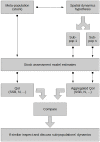Testing spatial heterogeneity with stock assessment models
- PMID: 29364901
- PMCID: PMC5783371
- DOI: 10.1371/journal.pone.0190791
Testing spatial heterogeneity with stock assessment models
Abstract
This paper describes a methodology that combines meta-population theory and stock assessment models to gain insights about spatial heterogeneity of the meta-population in an operational time frame. The methodology was tested with stochastic simulations for different degrees of connectivity between sub-populations and applied to two case studies, North Sea cod (Gadus morua) and Northeast Atlantic sardine (Sardina pilchardus). Considering that the biological components of a population can be partitioned into discrete spatial units, we extended this idea into a property of additivity of sub-population abundances. If the additivity results hold true for putative sub-populations, then assessment results based on sub-populations will provide information to develop and monitor the implementation of finer scale/local management. The simulation study confirmed that when sub-populations are independent and not too heterogeneous with regards to productivity, the sum of stock assessment model estimates of sub-populations' SSB is similar to the SSB estimates of the meta-population. It also showed that a strong diffusion process can be detected and that the stronger the connection between SSB and recruitment, the better the diffusion process will be detected. On the other hand it showed that weak to moderate diffusion processes are not easy to identify and large differences between sub-populations productivities may be confounded with weak diffusion processes. The application to North Sea cod and Atlantic sardine exemplified how much insight can be gained. In both cases the results obtained were sufficiently robust to support the regional analysis.
Conflict of interest statement
Figures








References
-
- Beverton RJH, Holt SJ. On the Dynamics of Exploitated Fish Populations. The Blackburn Press; 1957.
-
- Hilborn R, Walters CJ. Quantitative Fisheries Stock Assessment. Choice, Dynamics & Uncertainty. Kluwer Academic Publishers; 1992.
-
- Quinn TJ, Deriso RB. Quantitative Fish Dynamics. Oxford University Press; 1999.
-
- Jennings S, Kaiser MJ, Reynolds JD. Marine Fisheries Ecology. Blakwell Publishing; 2001.
-
- Haddon M. Modelling and Quantitative Methods in Fisheries. 2nd ed Chapman and Hall/CRC; 2011.
Publication types
MeSH terms
LinkOut - more resources
Full Text Sources
Other Literature Sources

